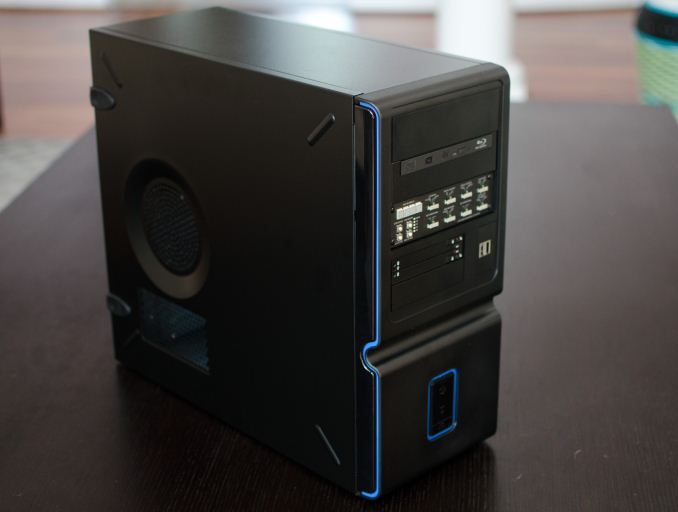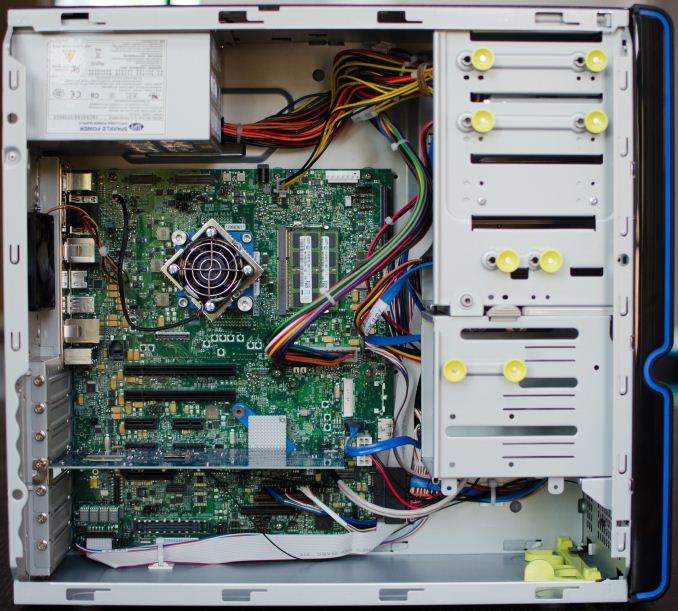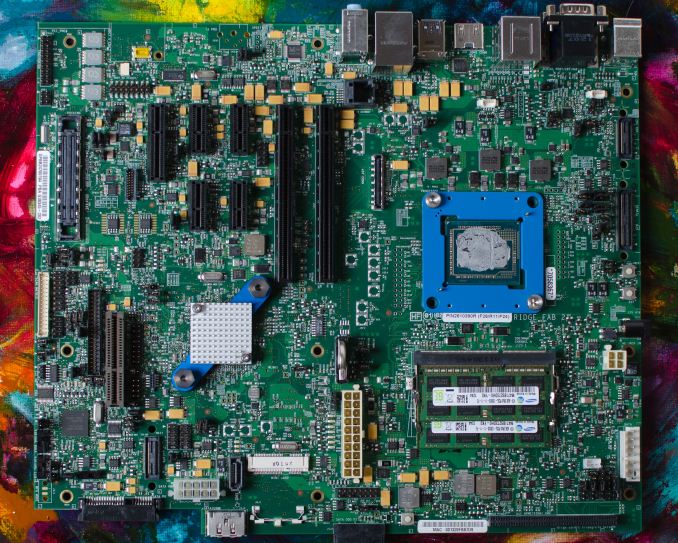Intel Iris Pro 5200 Graphics Review: Core i7-4950HQ Tested
by Anand Lal Shimpi on June 1, 2013 10:01 AM ESTThe Core i7-4950HQ Mobile CRB
At a high level, Iris Pro 5200 would seem to solve both problems that plagued Intel graphics in the past: a lack of GPU hardware and a lack of memory bandwidth. As a mostly mobile-focused design, and one whose launch partner isn’t keen on giving out early samples, it seemed almost impossible to evaluate Iris Pro in time for the Haswell launch. That was until a week ago when this showed up:
What may look like a funny mid-tower from a few years ago is actually home to one of Intel’s mobile Customer Reference Boards (CRB). Although the chassis is desktop-sized, everything inside is optimized for mobile. It’s just easier to build things larger, especially when it comes to testing and diagnosing problems.
The silicon on-board is a 47W Core i7-4950HQ, the lowest end launch SKU with Iris Pro 5200 graphics. The chassis is obviously overkill for a 47W part, but the performance we get with this machine should be representative of any i7-4950HQ system with a cooler capable of dissipating 47W.
If you read our Haswell CPU review you’ll know that Intel tried to be stingy with telling us die sizes and transistor counts for the bulk of the Haswell lineup, electing to only give us data on dual-core Haswell GT3 and quad-core Haswell GT2. Knowing that mobile parts ship without integrated heat spreaders, I went to work on pulling off the i7-4950HQ’s heatsink (after I finished testing, just in case).
With the heatsink off and thermal paste wiped off, I used my bargain basement calipers to get a rough idea of die area. This is what I came up with:
| Intel Haswell | |||||||||||||||||
| CPU Configuration | GPU Configuration | Die Size | Transistor Count | ||||||||||||||
| Haswell GT3e (QC) | Quad-Core | GT3e | 264mm2 + 84mm2 | ? | |||||||||||||
| Haswell GT2 (QC) | Quad-Core | GT2 | 177mm2 | 1.4B | |||||||||||||
| Haswell ULT GT3 | Dual-Core | GT3 | 181mm2 | 1.3B | |||||||||||||
The Crystalwell die measures 7mm x 12mm (84mm^2), while the quad-core Haswell + GT3 die is a whopping 264mm^2 (16.2mm x 16.3mm). Working backwards from the official data Intel provided (177mm^2 for quad-core GT2), I came up with an 87mm^2 adder for the extra hardware in Haswell GT3 vs. GT2. Doubling that 87mm^2 we get a rough idea of how big the full 40 EU Haswell GPU might be: 174mm^2. If my math is right, this means that in a quad-core Haswell GT3 die, around 65% of the die area is GPU. This is contrary to the ~33% in a quad-core Haswell GT2. I suspect a dual-core + GT3 design is at least half GPU.














177 Comments
View All Comments
whyso - Saturday, June 1, 2013 - link
They are completely different systems making power consumption values irrelevant.codedivine - Saturday, June 1, 2013 - link
Hi folks. Can you post the OpenCL extensions supported? You can use something like "GPU Caps viewer" from Geeks3d.tipoo - Saturday, June 1, 2013 - link
Interesting that the compute is punches above it's game performance weight. I wonder if they could put more EUs in a chip, maybe a larger eDRAM, and put it on a board as a compute card.lmcd - Saturday, June 1, 2013 - link
They already have a compute card called Xeon Phi if I remember correctly.Klimax - Sunday, June 2, 2013 - link
Different Arch (X86 in Phi)tipoo - Sunday, June 2, 2013 - link
I'm aware, but the Xeon Phi requires completely different programming than a GPU like this which can just use OpenCL.Soul_Master - Saturday, June 1, 2013 - link
What's your point for comparing desktop GPU with middle-range mobile GPU? CPU on both devices are not equal.Soul_Master - Saturday, June 1, 2013 - link
Sorry. I misunderstood about i7 4950HQ process, a high-end quad-core processor for laptops.Ryan Smith - Sunday, June 2, 2013 - link
It's what we had available. We wanted to test a DDR3 version of GK107, and that's what was on-hand.tipoo - Saturday, June 1, 2013 - link
Hmm, so it's heavily hinted at that the next rMBP will ditch discreet graphics. The 5200 is good, but that would still be a regression in performance. Not the first time Apple would have done that, there was the Radeon cut out of the Mini, the 320M to the 3000, even the bottom rung of the newest iMac with the 640m. I wonder if it would at least be cheaper to make up for it.